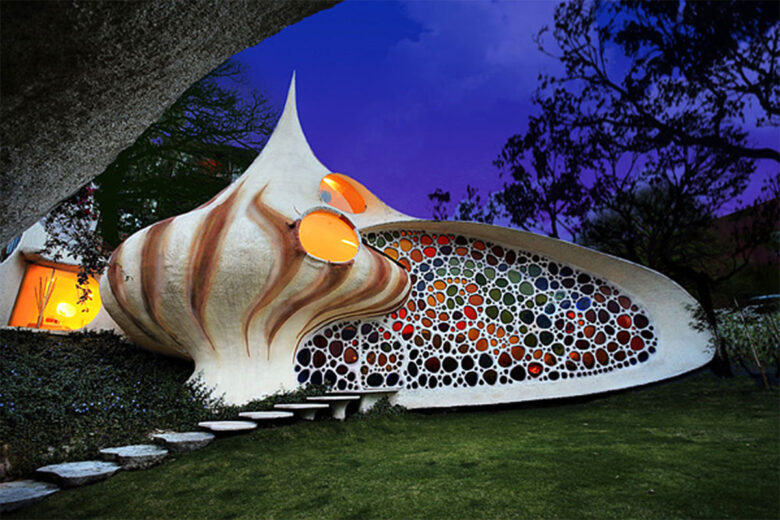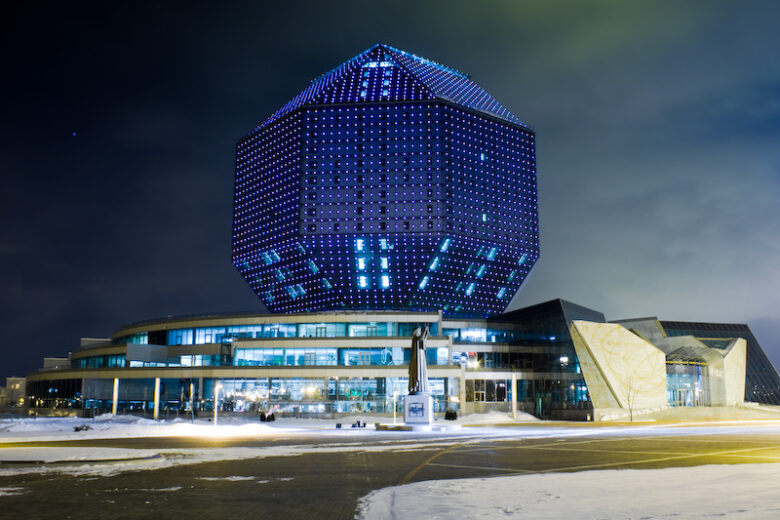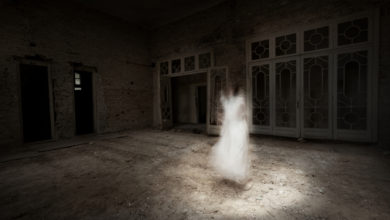35 Unusually Bizarre Buildings That Will Make You Say WTF
Architecture that is beyond your wildest dreams….one that leaves you bewildered and star-struck. Here’s presenting a list of those buildings that stood out from the rest.
1. Nautilus House – Mexico City, Mexico

The Nautilus House is a unique shell shaped house designed by Mexican architect Javier Senosiain. The house design is very innovative, unusual and audacious. Javier Senosiain decided to bring the life aquatic into architecture. A young family with two children from Mexico City were tired of living in a conventional home and wanted to change to one integrated to nature. The modern Nautilus House is wonderful to look at, walk through and enjoy for what it is – a blend of modern architecture and contemporary art. The sculptural whimsical house features a striking entry cut into a wall of colorful stained glass. Each element has been carefully chosen to coincide with the organic theme of the building.

Interiors of the Nautilus house

2. Habitat 67 – Montreal, Canada

Habitat 67 is a model community and housing complex in Montreal, Canada, designed by Israeli–Canadian architect Moshe Safdie. It comprises 354 identical, prefabricated concrete forms arranged in various combinations, reaching up to 12 stories in height. Together these units create 146 residences of varying sizes and configurations, each formed from one to eight linked concrete units. The complex originally contained 158 apartments but several apartments have since been joined to create larger units, reducing the total number. Each unit is connected to at least one private terrace, which can range from approximately 225 to 1,000 sq ft

Panoramic view of Habitat 67 as seen from Montreal’s port
3. Rotating Tower – Dubai, UAE

Visionary architect Dr. David Fisher is the creator of the world’s first building in motion. It will adjust itself to the sun, wind, weather and views by rotating each floor separately. This building will never appear exactly the same twice. In addition to being such an incredible engineering miracle it will produce energy for itself and even for other buildings because it will have wind turbines fitted between each rotating floor. So an 80-storey building will have up to 79 wind turbines, making it a true green power plant. It’s never the same when you see it. Keeps on rotating all the time! The cost of the building has been put at a whooping 2 Billion Dirhams.
4. Atomium – Brussels, Belgium

The Atomium is today the most popular attraction in the Capital of Europe. Built for the 1958 World Exhibition, the Atomium is shaped on the model of an elementary iron crystal enlarged 165 billion times. Beyond surreal walks through tubes and spheres, the Atomium houses a permanent exhibition about its history as well temporary exhibitions for a broad public. The upper sphere offers unique and spectacular views across the city skyline. At night, 2970 lights offer a fairy dimension to the 102m high building.

Atomium interior

Interior – Pavillion of happiness
5. Wonderworks – Pigeon Forge, TN, USA

It resembles an upside-down building, complete with inverted palm trees. It was built in 1998. The inside of the building has an upside-down appearance as well. In 2006, this second location was built in Pigeon Forge. In 2010, another location was built in Panama City Beach. Another one in Myrtle Beach, SC opened in 2011.
6. Cubic Houses (Kubus Woningan) – Rotterdam, Netherlands

One of the icons of Rotterdam are the cubic houses. 40 conventional houses were tilted 45 degrees to become the first cube-shaped houses in Holland. The cubes are prominently located in the center of Rotterdam. Structurally, the cubes sit tilted on a hexagonal pole. They are made up of concrete floors, concrete pillars and wooden framing. Inside, the houses are divided into three levels accessed via a narrow staircase. The lower level is a triangular area used as the living room. The middle level houses the sleeping and bathing area, and the highest level is a spare area used either as a second bedroom or another living area.

7. The Basket Building – Ohio, USA

The basket building is the 7-storey corporate headquarters of America’s famous basket manufacturer the Longaberger Basket Company. The basket is a replica — 160 times larger — of Longaberger’s Medium Market Basket. It is a magnificent sight – especially at night. Dave Longaberger, who founded the company, dreamed up the idea of running his growing organization from the world’s largest replica of a basket. Most of his employees, less farsighted than their leader, didn’t take Dave’s notion seriously when the plan was announced. Many were still astounded when they moved into the office, but the beauty of the building is beyond all imaginations and is the glory of Ohio’s skyline.
8. Borgund Stave Church – Norway

Built around 1180 and is dedicated to the Apostle Andrew. The church is exceptionally well preserved and is one of the most distinctive stave churches in Norway. Some of the finest features are the lavishly carved portals and the roof carvings of dragons’s heads. The stave churches are Norway’s most important contribution to world architecture and Norway’s oldest preserved timber buildings
9. The National Library – Minsk, Belarus

This 23-storey library is designed in the form of a rhombicuboctahedron (diamond) and symbolises the enormous value of knowledge that mankind has stored in books. The building is covered with glass panels and during the day all 24 sides sparkle like a real diamond. Architects Victor Kramarenko and Michael Vinogradov wanted to preserve and convey this vision at night.
10. National Theatre – Beijing, China

It is a curved building, with a total surface area of 149,500 square meters, that emerges like an island at the center of a lake. The titanium shell is in the shape of a super ellipsoid which is divided in two by a curved glass covering, 100 meters wide at the base. During the day, light flows through the glass roof into the building. At night, the movements within can be seen from outside.
11. Snail House – Sofia, Bulgaria

The construction of this Snail-House in Sofia’s Simeonovo district lasted almost 10 years and ended in 2009. The project idea belongs to the building owner, some Bulgarian construction specialist, who mostly involved in overseas high-end projects and did not want his name disclosed. It is a five-story family house in the form of funny colorful snail, with horns on its head and butterflies on the back. Internal design combines ancient antique furniture from owner’s ancestors with funny heating radiators in the form of a frog, a ladybug or pumpkin. The House has already become one of the most popular attractions in Sofia.
12. House Attack – Vienna, Austria

Erwin Wurm, a renowned Austrian artist, combined to create some architectural buzz in 2006, and the result was the “House Attack” artistic installation on the external side of the building of MUMOK. This artistic installation represents a family-home, which hits the facade of the museum like a “bomb”. “House Attack” is a confusion of our perception of art and everyday reality and in its striking appearance and humorous, dramatic staging of the banal is a perfect example of current developments in the artist’s work. Craftsmanship of the architect is shown in the fact that the House Attack exactly looks like someone threw the house onto the building. This funny building became famous throughout the world and is considered to be one of the most unusual landmarks representing contemporary art.
13. Pallais Bulles – Cannes, France

The iconic Bubble House just outside of Cannes was designed by renowned architect, Antti Lovag. The personal playground of famous avant-garde designer Pierre Cardin, the Bubble House is notorious for its legendary festival parties and other grand events. See below for a comprehensive gallery on this iconic European building along with information on the architect, the property and owner. Enjoy!
14. Olympic Stadium – Montreal, Canada

Built to welcome the 1976 Olympic Games, the Olympic Park has become the international symbol of the city of Montréal. The Olympic Park Tower is the tallest inclined tower in the world, with its 165 m rising at angle of 45 degrees (to compare, the Tower of Pisa has an inclination of only 5 degrees).

15. Museum of Contemporary Art – Niteroi, Rio de Janeiro, Brazil

It was designed by the famed Brazilian architect Oscar Niemeyer and completed in 1996. This iconic saucer-shaped structure, situated on a cliffside above Guanabara bay in the city of Niterói, brilliantly frames the panoramic views of the city of Rio De Janeiro and encapsulates the simple, yet brilliant signature aesthetic of Niemeyer.

16. Sagrada Familia – Barcelona, Spain

The Sagrada Família, Antoni Gaudí’s unfinished masterpiece, is one of Barcelona’s most popular tourist attractions. Construction on this church will continue for at least another decade, but it has already become Barcelona’s most important landmark. Because Gaudí was constantly improvising and changing the design while construction was going on, he left few designs and models. And most of these were destroyed in 1936 during the Civil War. Still, architects now have a clear idea of what Gaudí had in mind. The last version of his design called for a church 95m long and 60m wide. The church will be able to accommodate some 13 000 people. When finished, the Sagrada Família will have a total of eighteen towers.

Interiors of Sagrada Familia
17. The Crooked House – Sopot, Poland

It is an irregularly-shaped building which was built in 2004. It is approximately 4,000 sq m in size and is part of the Rezydent shopping center. It was designed by Szoty?scy & Zaleski who were inspired by the fairytale illustrations and drawings of Jan Marcin Szancer and Per Dahlberg.
18. Waldspirale – Darmstadt, Germany

The building’s name, which means “forest spiral” in German, refers to its spiraling floor plan and its forested roof and courtyard. The structure wraps around a landscaped courtyard with a running stream. This is the first high-rise in Germany built out of recycled concrete. The roof supports a garden of maple, beech, and lime trees and has space to accommodate 6 private parties at the same time.
19. Kansas City Public Library – Kansas City, USA

One of the most striking features of the building is the facade of the parking garage for the Central Branch of the public library. Covered in signboard mylar, the garage appears to be a row of books lined up on a shelf except in this case the “books” are 25 feet high and nine feet wide. The garage behind the “books” was constructed in 2006 in response to the need for additional downtown parking. Community members and patrons were asked to vote on the titles to be displayed and the ones chosen reflect a wide range of famous literature. Titles of the 22 volumes represented include The Lord of the Rings, Fahrenheit 451 and Romeo and Juliet among many others.
20. Air force Academy Chapel – Colorado, USA

Completed in 1962, the building is the distinguishing feature of the Cadet Area at the United States Air Force Academy north of Colorado Springs. It was designed by Walter Netsch of Skidmore, Owings and Merrill of Chicago. The most striking aspect of the Chapel is its row of 17 spires. The shell of the chapel and surrounding grounds cost $3.5 million to build. Various furnishings, pipe organs, liturgical fittings and adornments of the chapel were presented as gifts from various individuals and organizations.
21. Kunsthaus Graz – Graz, Austria

The Friendly Alien Building – The Austrian city of Graz has its own ultra-modern art museum. Designed by Sir Peter Cook and Colin Fournier, the brilliant Kunsthaus Graz is an architectural landmark in the city center, serving as a bridge between the historic and the modern. Known to locals as the “Friendly Alien,” the blob-shaped structure contains contemporary art, design, new media, film and photography. Although the building makes quite a statement, its environmental impact is very low, as the building’s organic roof — made from 1,288 semitransparent acrylic glass panels — generates energy with built-in photovoltaic panels.
22. Conch Shell House – Isla Mujeres, Mexico

The Conch Shell Hose is said to be the most outstanding and original house in the island of Isla Mujeres. Surrounded by Caribbean Ocean (180 degrees of ocean views from the windows) it gives you an unique opportunity to experience what it’s like living in a Sea Shell. The conch shell house was built using a fairly traditional foundation, such as concrete, as well as recycled and found materials. If you enter the house you would be surrounded by a wonderful shell themed interior. The main room has no corners – it is round. The upstairs bathroom sink is made out of the base of a conch shell, the faucets are made out of coral, the towel racks are made from conch shells and other seashells and items found on the local beach.

23. China Central Television Headquarters – Beijing, China

The new headquarters of China Central Television (CCTV) is a 234m tall building with a highly unusual shape, described as a ‘three-dimensional cranked loop’. The building is formed by two leaning towers, bent 90° at the top and bottom to form a continuous tube. Before the 2 towers were linked, they were prone to independent movement from wind, and surface temperature variations because of direct sunlight. Construction issues were therefore a key consideration of the design process and it was crucial to analyse the way the structure behaved in its partially-constructed form.
24. Stone House – Guimaraes, Portugal

Constructed between two giant stones and linked with a concrete mix, the house is rumored to be inspired by the popular American Flintstones cartoon. Although quite unusual, the prehistoric-looking residence does feature some traditional components such as windows, a front door, and even a shingled roof. As you might expect, the house’s design attracts thousands of tourists each year.
25. Upside Down House – Szymbark, Poland

A unique house that stands on its roof, where visitors walk on the ceilings and which is decorated in the socialist style of the 1970’s. It was built on its roof. The “Upside Down House” evokes a strange feeling – entry is through a roof window and visitors walk around on the ceilings. The interior is furnished in the style of socialist realism – there is a TV room and a dresser with crystal objects, a toilet from the 1970’s and propaganda of the time coming from the television. The building of this house took longer and was a lot more expensive than a normal house of this size.
26. The Church of Hallgrimur – Reykjavik, Iceland

The church of Hallgrímur is a Lutheran parish church.. At 74.5 m, it is the largest church in Iceland and the sixth tallest architectural structure in Iceland. State Architect Guðjón Samúelsson’s design of the church was commissioned in 1937. He is said to have designed it to resemble the basalt lava flows of Iceland’s landscape.It took 38 years to build the church. Construction work began in 1945 and ended in 1986
27. Walt Disney Concert Hall – Los Angeles, USA

The visual salience of the Walt Disney Concert Hall lies in its exquisite stainless steel exterior and complex postmodern style. The Walt Disney Concert Hall, also known as Disney Hall, is the fourth hall to join the Los Angeles Music Center. Its sleek curves and intricate structural patterns are matched by no other concert hall in the United States. Disney Hall possesses a caliber and an architectural merit that attract tourists from far and wide.
28. Low Impact Woodland House – Wales, UK

The Hobbit Home. The house was built with maximum regard for the environment and by reciprocation gives us a unique opportunity to live close to nature. This building is one part of a low-impact or permaculture approach to life. This sort of life is about living in harmony with both the natural world and ourselves, doing things simply and using appropriate levels of technology. It was built by Simon Dale and his father in law with help from passers by and visiting friends. 4 months after starting they were moved in and cosy.

Interiors of The Hobbit Home
29. Seattle Central Library – Seattle, USA

The architects conceived the new Central Library building as a celebration of books, deciding after some research that despite the arrival of the 21st century and the “digital age,” people still respond to books printed on paper. Although the library is an unusual shape from the outside, the architects’ philosophy was to let the building’s required functions dictate what it should look like, rather than imposing a structure and making the functions conform to that.
30. Eden Project – UK

The Eden Project is a visitor attraction in Cornwall in UK. Inside the artificial biomes are plants that are collected from all around the world. The complex is dominated by two huge enclosures consisting of adjoining domes that house thousands of plant species, and each enclosure emulates a natural biome. The domes consist of hundreds of hexagonal and pentagonal, inflated, plastic cells supported by steel frames. The first dome emulates a tropical environment, and the second a Mediterranean environment.
31. Montreal Biosphere – Montreal Canada

The building originally formed an enclosed structure of steel and acrylic cells, 76 m in diameter and 62 m high. The Biosphère is a museum in Montreal dedicated to the environment. The architect of the geodesic dome was Buckminster Fuller.
32. The Gherkin Building – London, UK

It is one of the most eye-catching buildings in London and it stands out prominently in the city’s skyline. The Gherkin is one of several modern buildings that have been built over the years in a historic area of London. The cigar-shaped structure has a steel frame with circular floor plans and a glass facade with diamond-shaped panels. The swirling striped pattern visible on the exterior is the result of the building’s energy-saving system which allows the air to flow up through spiraling wells. Its unique, bold and energy efficient design has won the Gherkin many awards
33. Experience Music Project – Seattle, USA

It was founded by Paul Allen, the co-founder of Microsoft. It is a museum of music history sited near the Space Needle. The museum contains mostly rock memorabilia and technology-intensive multimedia displays. The structure is also home to the Science Fiction Museum and Hall of Fame. It was designed by Frank Gehry. The structure contains 140,000 sq ft with a 35,000-sq ft footprint. Herbert Muschamp (New York Times architecture critic) described it as “something that crawled out of the sea, rolled over, and died.” Forbes magazine called it one of the world’s 10 ugliest buildings.

34. Dancing House – Prague, Czech Republic

The very non-traditional design of the Dancing house was controversial at the time. Czech president Václav Havel, had supported it, hoping that the building would become a center of cultural activity. The building includes several offices and a French Restaurant on the roof.
35. The National Stadium – Beijing, China

Stadium is the world’s largest steel structure.The design was awarded to a submission from the Swiss architecture firm Herzog & de Meuron in April 2003, after a bidding process that included 13 final submissions. The design, which originated from the study of Chinese ceramics, implemented steel beams in order to hide supports for the retractable roof; giving the stadium the appearance of a “Bird’s nest”.
Related Posts:
- 35 Unusually Bizarre Buildings That Will Make You Say WTF
- These 49 Simple But Brilliant Product Ideas Will…
- If This Father And Daughter Photo Tribute Does Not…
- 17 Outstanding Truths About Modern Dating That'll…
- 39 Absolutely Terrible Puns That Will Make You Laugh…
- 24 Rib-Tickling and Hilarious Wet Cats That Will…
- 31 Soul Stirring and Absolutely Touching Images From…
- 30 Things That If You Stop Doing Will Make Every…
- 31 Hilarious Chinese Translation Errors That Would…
- 39 Absolutely Terrible Puns That Will Make You Laugh…




